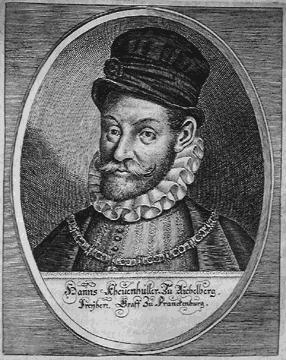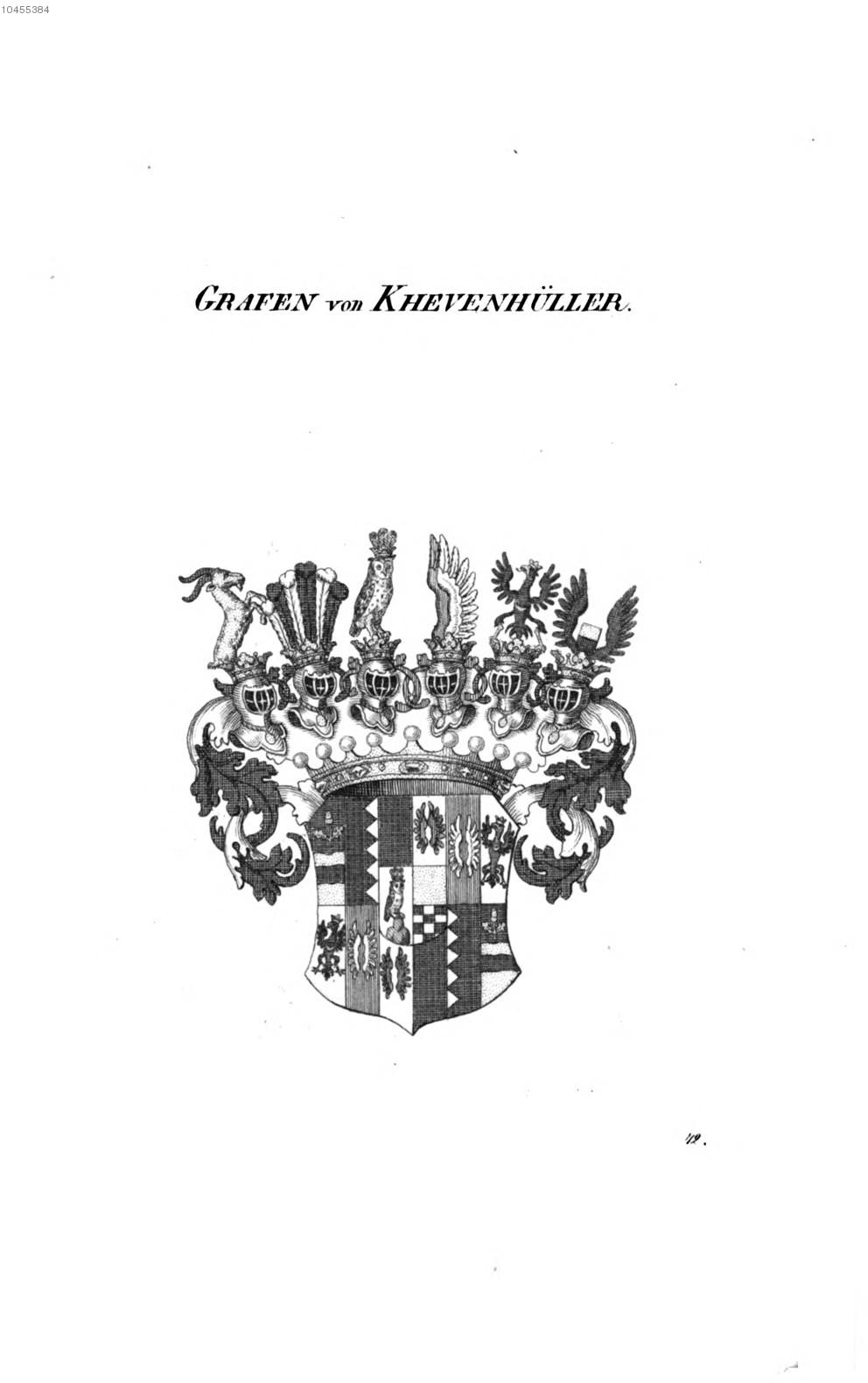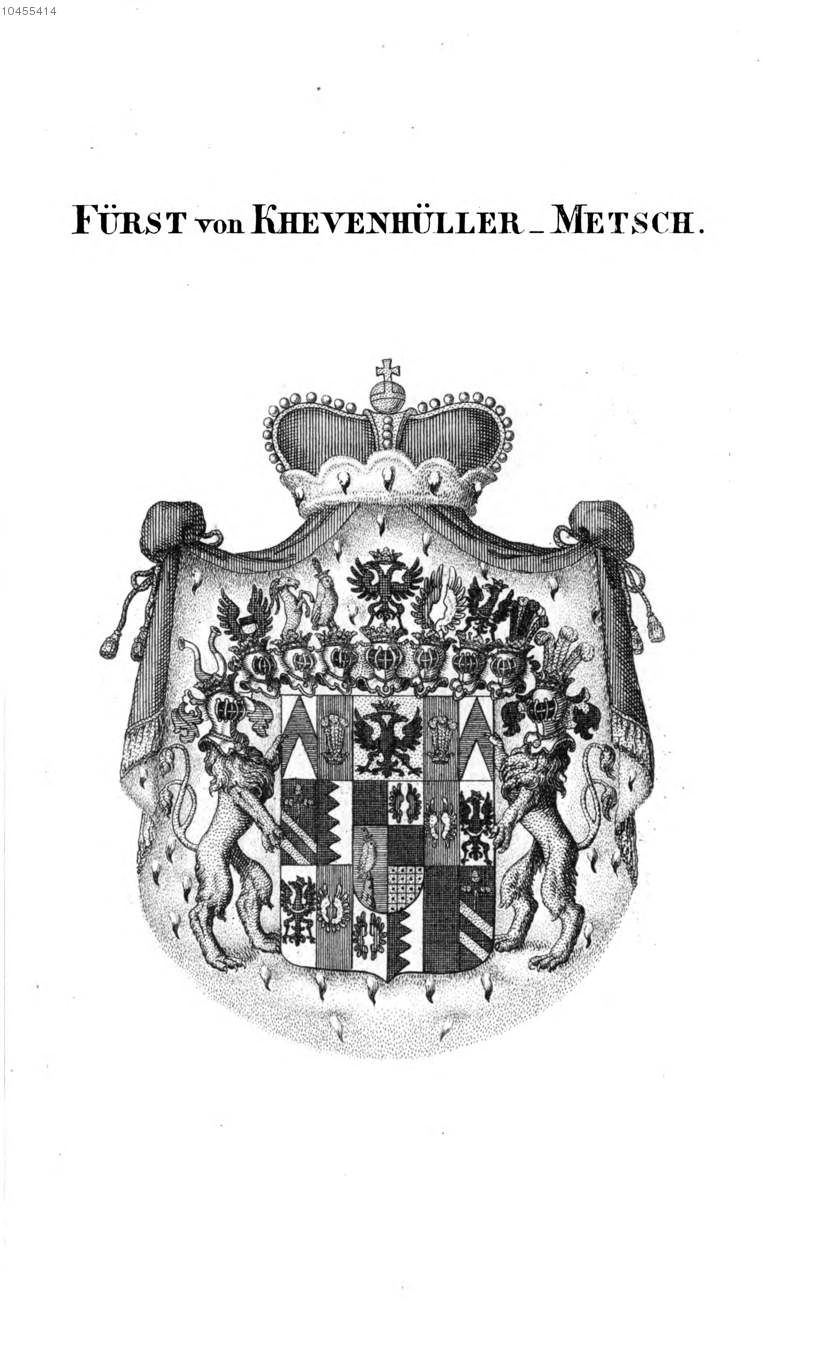Khevenhüller Family on:
[Wikipedia]
[Google]
[Amazon]
 The House of Khevenhüller is the name of an old Carinthian noble family, documented there since 1356, with its ancestral seat at Landskron Castle. In the 16th century, the family split into the two branches of Khevenhüller-Frankenburg, Imperial Counts (i.e. immediate counts of the Holy Roman Empire) from 1593, and Khevenhüller-Hochosterwitz, raised to Imperial Counts in 1725 and, as Khevenhüller-Metsch, to princely rank (''
The House of Khevenhüller is the name of an old Carinthian noble family, documented there since 1356, with its ancestral seat at Landskron Castle. In the 16th century, the family split into the two branches of Khevenhüller-Frankenburg, Imperial Counts (i.e. immediate counts of the Holy Roman Empire) from 1593, and Khevenhüller-Hochosterwitz, raised to Imperial Counts in 1725 and, as Khevenhüller-Metsch, to princely rank (''

 * Ludwig Andreas Khevenhüller Graf von Aichelberg-Frankenburg (1683–1744), Austrian field marshal
* Johann Joseph Fürst Khevenhüller-Metsch (1706–1776), Lord Great Chamberlain ("Oberstkämmerer") of
* Ludwig Andreas Khevenhüller Graf von Aichelberg-Frankenburg (1683–1744), Austrian field marshal
* Johann Joseph Fürst Khevenhüller-Metsch (1706–1776), Lord Great Chamberlain ("Oberstkämmerer") of 

Burg HochosterwitzWebsite of Hochosterwitz Castle
(owned by the princely family of Khevenhüller-Metsch)
*
* {{DEFAULTSORT:Khevenhuller Austrian noble families Lists of princes German families Carinthia (state) People from Carinthia (state) Spanish noble families
Fürst
' (, female form ', plural '; from Old High German ', "the first", a translation of the Latin ') is a German word for a ruler and is also a princely title. ' were, since the Middle Ages, members of the highest nobility who ruled over states of ...
en'') in 1763. The family belongs to high nobility.
In the present-day Austrian state of Carinthia
Carinthia (german: Kärnten ; sl, Koroška ) is the southernmost States of Austria, Austrian state, in the Eastern Alps, and is noted for its mountains and lakes. The main language is German language, German. Its regional dialects belong to t ...
, the princely family of Khevenhüller-Metsch owns the Renaissance castle of Hochosterwitz
Hochosterwitz Castle (german: Burg Hochosterwitz, sl, Grad Ostrovica) is a castle in Austria, considered one of Austria's most impressive medieval castles. It is on a high dolomite rock near Sankt Georgen am Längsee, east of the town of Sankt ...
, a significant edifice and major tourist attraction.
History
The noble family originally possibly originated in Kevenhüll (today part ofBeilngries
Beilngries (; bar, Beilngrias) is a town in the district of Eichstätt, in Bavaria, Germany. It is situated on the river Altmühl and the Rhine-Main-Danube Canal, 30 km north of Ingolstadt.
Sons and daughters of the city
* Rosa Aschenb ...
) in Franconia; they were vassals of the Bishops of Bamberg, who had received large estates in Carinthia from the hands of King Henry II of Germany in 1007. The earliest mention refers to one ''Ulreich dem Chevenhuelaer'' in a 1330 deed. In Carinthia, a continuous line descends from one Johann I (Hans) Khevenhüller, who died in 1356 and was the son-in-law of Richard I von Khünburg and Elisabeth von Himmelberg, both from Carinthia.
Johann IV von Khevenhüller zu Aichelberg (born ca 1420-1462) was the first to hold the family lordship of Aichelberg
Aichelberg is a municipality in the district of Göppingen in Baden-Württemberg in southern Germany.
Aichelberg is between Stuttgart and Ulm at the ''Albaufstieg'', the slope of the Swabian Jura in 357–615 meters altitude. Characteristic of t ...
. His son, Johann V Khevenhüller (died 1462), son of Wilhelm II Khevenhüller and Margareta von Auersperg, was Burgrave of Federaun, and ''his'' son, Augustin Khevenhüller, who died 1516, was the Lord of Hardegg. His mother was one "Miss" von Lindegg, who together with her grandson Sigismund III, Herr Khevenhüller in Hohen-Osterwitz (1507–1558) appears among the ancestors of King Charles III. Her youngest grandson, Bernard von Khevenhüller (1511–1548) was the Lord of Sternberg and Hohenwart; her eldest grandson, Christoph Khevenhüller (1503–1557) was Lord of Aichelberg.

Christoph Khevenhüller
The steep rise of the House of Khevenhüller in Carinthia began when in 1525 Christoph Khevenhüller (1503–57) was appointedcastellan
A castellan is the title used in Medieval Europe for an appointed official, a governor of a castle and its surrounding territory referred to as the castellany. The title of ''governor'' is retained in the English prison system, as a remnant o ...
of Ortenburg Castle near Spittal an der Drau and married a wealthy burgher's daughter, Elizabeth Mansdorfer.
Her wealth enabled him to acquire a number of properties in Carinthia such as the castles of Aichelberg
Aichelberg is a municipality in the district of Göppingen in Baden-Württemberg in southern Germany.
Aichelberg is between Stuttgart and Ulm at the ''Albaufstieg'', the slope of the Swabian Jura in 357–615 meters altitude. Characteristic of t ...
, Ortenburg, Sommeregg, Hochosterwitz
Hochosterwitz Castle (german: Burg Hochosterwitz, sl, Grad Ostrovica) is a castle in Austria, considered one of Austria's most impressive medieval castles. It is on a high dolomite rock near Sankt Georgen am Längsee, east of the town of Sankt ...
and Landskron as well as the iron mine of Eisentratten near Gmünd. Like the majority of the Carinthian Estates, Christoph Khevenhüller became a Lutheran Protestant. Of Christoph Khevenhüller's three sons, Hans, Moritz and Bartlmäus, two were politically and economically most successful, thus furthering the rise of the family:
Hans Khevenhüller
Hans Khevenhüller (1538–1606) became the Legate of theHoly Roman Emperor
The Holy Roman Emperor, originally and officially the Emperor of the Romans ( la, Imperator Romanorum, german: Kaiser der Römer) during the Middle Ages, and also known as the Roman-German Emperor since the early modern period ( la, Imperat ...
at the Spanish court, an office that he held for 26 years. Educated at the University of Padua, he knew Latin and Italian. He was appointed Imperial Chamberlain, was made a Knight of the Order of the Golden Fleece
The Distinguished Order of the Golden Fleece ( es, Insigne Orden del Toisón de Oro, german: Orden vom Goldenen Vlies) is a Catholic order of chivalry founded in Bruges by Philip the Good, Duke of Burgundy, in 1430, to celebrate his marriage ...
in 1587 and a count in 1593, a rank that upon his death passed on to his brother Bartlmäus. During his lifetime, he sought and collected animals and plants of economic importance from many parts of the world.
Bartlmäus Khevenhüller
The activities of Bartlmäus Khevenhüller (1539–1613) centred on Carinthia. Styling himself "Freiherr auf Landskron and Wernberg" he made it toBurggrave
Burgrave, also rendered as burggrave (from german: Burggraf, la, burgravius, burggravius, burcgravius, burgicomes, also praefectus), was since the medieval period in Europe (mainly Germany) the official title for the ruler of a castle, especiall ...
und Speaker of the Estates, and managed to make the Khevenhüller family one of the wealthiest in the German Reich. He also figured as the head of the Protestants
Protestantism is a branch of Christianity that follows the theological tenets of the Protestant Reformation, a movement that began seeking to reform the Catholic Church from within in the 16th century against what its followers perceived to b ...
in Carinthia.
When in the course of the counter-reformation
The Counter-Reformation (), also called the Catholic Reformation () or the Catholic Revival, was the period of Catholic resurgence that was initiated in response to the Protestant Reformation. It began with the Council of Trent (1545–1563) a ...
Emperor Ferdinand II abolished the nobility's religious freedom in the Habsburg
The House of Habsburg (), alternatively spelled Hapsburg in Englishgerman: Haus Habsburg, ; es, Casa de Habsburgo; hu, Habsburg család, it, Casa di Asburgo, nl, Huis van Habsburg, pl, dom Habsburgów, pt, Casa de Habsburgo, la, Domus Hab ...
lands, the Protestant members of the Khevenhüller family were forced to abandon their possessions in Carinthia and emigrated to Germany in 1628. Among these was also the great-grandmother of Nicolaus Ludwig Reichsgraf von Zinzendorf und Pottendorf of the Moravian Church or ''Herrnhuter Brüdergemeine''. Interrelation with the noble Saxonian
Saxony (german: Sachsen ; Upper Saxon: ''Saggsn''; hsb, Sakska), officially the Free State of Saxony (german: Freistaat Sachsen, links=no ; Upper Saxon: ''Freischdaad Saggsn''; hsb, Swobodny stat Sakska, links=no), is a landlocked state of ...
Metzsch family began that led to the Khevenhüller-Metsch branch, which later also spread to Spain where as marquesses and dukes they became Grandees of Spain.
Paul Khevenhüller
A Protestant, Paul Khevenhüller (1593–1655) sided with the Swedish king during the Thirty Years' War lending Gustav Adolf 70,000Swedish riksdaler
The svenska riksdaler () was the name of a Swedish coin first minted in 1604. Between 1777 and 1873, it was the currency of Sweden. The daler, like the dollar,''National Geographic''. June 2002. p. 1. ''Ask Us''. was named after the German Thaler. ...
s to finance the war. After the king's death the Swedish state was incapable of repaying the loan and compensated the lender with the property of Julita Gård in Södermanland, which remained the residence of his descendants late into the 19th century.
Notable members of the House of Khevenhüller
* Ulrich Khevenhüller (b. ca. 1430–1492), youngest son of Hans II Khevenhüller, knight *George Khevenhüller
Georg von Khevenhüller (, also spelled as Gjuro or George Khevenhiller; 22 April 1533 – 9 September 1587) was a Duchy of Carinthia, Carinthian Austrian nobility, nobleman of the Khevenhüller dynasty. Though a dedicated Protestant Reformation, ...
(1533–1587), "State Captain", i.e. governor of the Duchy of Carinthia
The Duchy of Carinthia (german: Herzogtum Kärnten; sl, Vojvodina Koroška) was a duchy located in southern Austria and parts of northern Slovenia. It was separated from the Duchy of Bavaria in 976, and was the first newly created Imperial Sta ...
.
* Hans Graf Khevenhüller-Frankenburg (1538–1606), Imperial ambassador to the Spanish Court.
* Franz Christoph Graf von Khevenhüller-Frankenburg (1588–1650), Imperial ambassador to the Spanish Court
* Paul Khevenhüller (1593–1655), financier of the Swedish king in the Thirty Years' War
* Sigmund Friedrich von Khevenhüller (1666–1742), governor of the Duchy of Carinthia, vicegerent''often incorr. called ″vice-regent"''. The Cassell English Dictionary, London 1990, p. 1469 of the Duchy of Lower Austria.
 * Ludwig Andreas Khevenhüller Graf von Aichelberg-Frankenburg (1683–1744), Austrian field marshal
* Johann Joseph Fürst Khevenhüller-Metsch (1706–1776), Lord Great Chamberlain ("Oberstkämmerer") of
* Ludwig Andreas Khevenhüller Graf von Aichelberg-Frankenburg (1683–1744), Austrian field marshal
* Johann Joseph Fürst Khevenhüller-Metsch (1706–1776), Lord Great Chamberlain ("Oberstkämmerer") of Maria Theresa
Maria Theresa Walburga Amalia Christina (german: Maria Theresia; 13 May 1717 – 29 November 1780) was ruler of the Habsburg dominions from 1740 until her death in 1780, and the only woman to hold the position ''suo jure'' (in her own right). ...
* Johann Carl Khevenhüller (1839–1905), member of Maximilian I of Mexico
Maximilian I (german: Ferdinand Maximilian Josef Maria von Habsburg-Lothringen, link=no, es, Fernando Maximiliano José María de Habsburgo-Lorena, link=no; 6 July 1832 – 19 June 1867) was an Austrian archduke who reigned as the only Emperor ...
's corps of volunteers


Princes of Khevenhüller-Metsch
* Johann Joseph Khevenhüller-Metsch (1706–1776), son of the former, 1763 Prince von Khevenhüller-Metsch; married to Karolina Maria Augustina Countess von Metsch, daughter of Count Johann Adolf * Johann Sigismund Friedrich (1732–1801), son of the former, 2nd Prince von Khevenhüller-Metsch; ∞ I Maria Amalia Susanna, Princess of Liechtenstein, daughter of Prince Emanuel; married to II Marie Josephine Henriette Barbara Countess of Strassoldo, daughter of Vinzenz * Karl Maria Joseph Johann Baptist Clemens (1756–1823), son of the former, 3rd Prince von Khevenhüller-Metsch; married to Therese Countess Morzin, daughter of Karl Joseph * Franz Maria Johann Joseph Hermann (1762–1837), brother of the former, 4th Prince von Khevenhüller-Metsch; married to I Maria Elisabeth Countess of Kuefstein, daughter of Johann Adam; married to II Maria Josepha Countess of Abensberg and Traun, daughter of Otto; married to III Christina Countess Zichy of Zich and Vasonykeö, daughter of Karl * Richard Maria Johann Basil (1813–1877), son of the former, 5th Prince zu Khevenhüller-Metsch; married to Antonia Maria Countess Lichnowsky, daughter of Prince Eduard * Johannes Franz Karl Eduard Joseph Nemesius (1839–1905), son of the former, 6th Prince zu Khevenhüller-Metsch; married to Eduardine Countess von Clam-Gallas, daughter of Eduard * Anton Sigismund Joseph Maria (1873–1945), nephew of the former, until 1919 (abolition of aristocratic titles) the 7th Prince zu Khevenhüller-Metsch; married to Gabriele Countess von Mensdorff-Pouilly * Franz Khevenhüller-Metsch (1889–1977); married to Anna Princess zu Fürstenberg (1894–1928), daughter of Maximilian Egon Prince zu Fürstenberg * Maximilian Khevenhüller-Metsch (1919–2010) married to Wilhelmine Gräfin Henckel von Donnersmarck (born 1932), daughter of Lazarus Graf Henckel von Donnersmarck (1902–1991) and Franziska Gräfin von und zu Eltz (1905–1997) * Johannes Khevenhüller-Metsch (1956–2020); married to Donna Camilla Borghese dei Principi di Nettuno (born 1962), daughter of Don Giovanni-Angelo Borghese dei Principi di Nettuno and Donna Lydia dei Conti CremisiniCurrent head of the Khevenhüller-Metsch family
* Johannes Khevenhüller-Metsch (born as Maria Johannes Franz Xaver Lazarus Maximilian Felix Hubertus 10e Fürst von Khevenhüller-Metsch; 1956); married to Donna Camilla Borghese dei Principi di Nettuno (born 1962) * Maximilian, 9th Prince 1977-2010 (1919-2010) ** Johannes, 10th Prince 2010-2020 (1956-2020) ** Bartholomäus, 11th Prince 2020–present (b.1958) *** Prince Ludwig (b.1988) *** Prince Philipp (b.1998) ** Prince Karl (b.1959) *** Prince Maximilian (b.1993) *** Prince Franz (b.1995) *** Prince Sigismund (b.1997) ** Prince Georg (b.1960)Spanish branch
*''Don'' Camillo Ruspoli y Khevenhüller-Metsch, Duke of Sueca (1788–1864), married Carlota de Godoy, 2nd Duchess of Sueca *''Don'' Adolfo Ruspoli, 2nd Duke of Alcudia (1822–1914), Grandee of Spain First Class *''Don''Luigi Ruspoli, 3rd Marquis of Boadilla del Monte
Don Luigi Ruspoli y Godoy, de Khevenhüller-Metsch y Borbón, dei Principi Ruspoli (August 22, 1828 in Florence – December 21, 1893 in Florence) was an Italian and Spanish aristocrat, son of the Prince Camillo Ruspoli and wife Carlota de Godo ...
(1828–1893)
Notes
References
* Bernhard Czerwenka, ''Die Khevenhüller'', Vienna: Braumüller, 1867. * Karl Dinklage, ''Kärnten um 1620. Die Bilder der Khevenhüllerchronik'', Vienna: Edition Tusch, 1980. * Franz Müllner,''Johann Carl Fürst Khevenhüller-Metsch, ein Kampfgefährte Kaiser Maximilians von Mexiko''. In ''Maximilian von Mexiko 1832-1867'', Vienna: Enzenhofer, 1974.External links
Burg Hochosterwitz
(owned by the princely family of Khevenhüller-Metsch)
*
* {{DEFAULTSORT:Khevenhuller Austrian noble families Lists of princes German families Carinthia (state) People from Carinthia (state) Spanish noble families